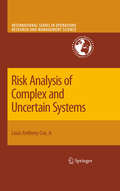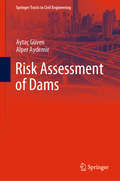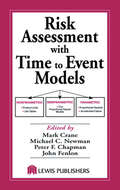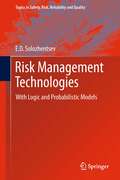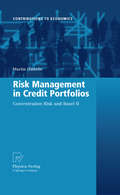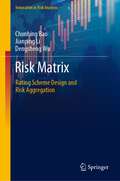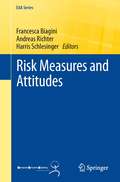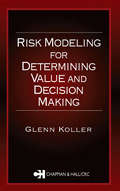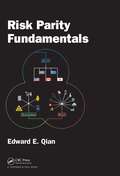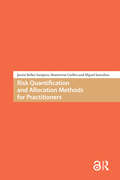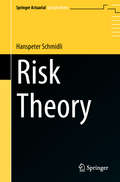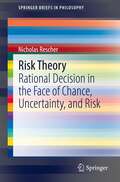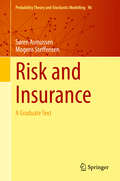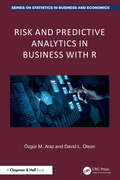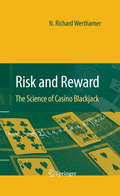- Table View
- List View
Risk Analysis of Complex and Uncertain Systems
by Louis Anthony Cox Jr.In Risk Analysis of Complex and Uncertain Systems acknowledged risk authority Tony Cox shows all risk practitioners how Quantitative Risk Assessment (QRA) can be used to improve risk management decisions and policies. It develops and illustrates QRA methods for complex and uncertain biological, engineering, and social systems - systems that have behaviors that are just too complex to be modeled accurately in detail with high confidence - and shows how they can be applied to applications including assessing and managing risks from chemical carcinogens, antibiotic resistance, mad cow disease, terrorist attacks, and accidental or deliberate failures in telecommunications network infrastructure. This book was written for a broad range of practitioners, including decision risk analysts, operations researchers and management scientists, quantitative policy analysts, economists, health and safety risk assessors, engineers, and modelers.
Risk Assessment and Decision Analysis with Bayesian Networks
by Norman Fenton Martin NeilSince the first edition of this book published, Bayesian networks have become even more important for applications in a vast array of fields. This second edition includes new material on influence diagrams, learning from data, value of information, cybersecurity, debunking bad statistics, and much more. Focusing on practical real-world problem-solving and model building, as opposed to algorithms and theory, it explains how to incorporate knowledge with data to develop and use (Bayesian) causal models of risk that provide more powerful insights and better decision making than is possible from purely data-driven solutions. Features Provides all tools necessary to build and run realistic Bayesian network models Supplies extensive example models based on real risk assessment problems in a wide range of application domains provided; for example, finance, safety, systems reliability, law, forensics, cybersecurity and more Introduces all necessary mathematics, probability, and statistics as needed Establishes the basics of probability, risk, and building and using Bayesian network models, before going into the detailed applications A dedicated website contains exercises and worked solutions for all chapters along with numerous other resources. The AgenaRisk software contains a model library with executable versions of all of the models in the book. Lecture slides are freely available to accredited academic teachers adopting the book on their course.
Risk Assessment and Decision Making in Business and Industry: A Practical Guide, Second Edition
by Glenn KollerBuilding upon the technical and organizational groundwork presented in the first edition, Risk Assessment and Decision Making in Business and Industry: A Practical Guide, Second Edition addresses the many aspects of risk/uncertainty (R/U) process implementation. This comprehensive volume covers four broad aspects of R/U: general concepts, i
Risk Assessment of Dams (Springer Tracts in Civil Engineering)
by Aytaç Güven Alper AydemirThis book offers a timely report on methods for risk assessment procedures for dams, with a special emphasis on dams with small storage dimensions. It starts by introducing all important definitions relating to dams, dam safety, such as the most common failure modes, and risks. In turn, it describes in detail the most important evaluation procedures for various failure modes such as piping, flood, earthquake and stability are described in this chapter. Consequence assessment procedures, together with the different steps of the risk evaluation process, are analyzed, providing a guide on how to identify the appropriate failure mode for the examined dam and setting up the appropriate safety plan. The book introduces the most common methods for predicting peak breach discharge, analyzing some relevant case studies. Upon comparing the findings obtained with the different methods, the book concludes with some general suggestions and ideas for future developments. This book fills an important gap between theoretical works and real-life problems being investigating in practical research studies on dam safety and risk management. It provides readers with the necessary knowledge on risk analysis and shows how to apply this in practice to carry out dam safety studies. It offers practical guidelines to set up risk assessment procedures for different failure modes and predicting failure parameters such as failure time, peak breach discharge and breach width.
Risk Assessment with Time to Event Models (Environmental and Ecological Risk Assessment)
by Michael C. Newman Mark Crane Peter F. Chapman John FenlonHow can environmental regulators use information on 48-hour toxicity tests to predict the effects of a few minutes of pollution? Or, at the other extreme, what is the relevance of 96-hour toxicity data for organisms that may have been exposed to a pollutant for six months or more? Time to event methods are the key to answering these types of questi
Risk Assessment: Theory, Methods, and Applications (Statistics in Practice)
by Marvin Rausand Stein HaugenIntroduces risk assessment with key theories, proven methods, and state-of-the-art applications Risk Assessment: Theory, Methods, and Applications remains one of the few textbooks to address current risk analysis and risk assessment with an emphasis on the possibility of sudden, major accidents across various areas of practice—from machinery and manufacturing processes to nuclear power plants and transportation systems. Updated to align with ISO 31000 and other amended standards, this all-new 2nd Edition discusses the main ideas and techniques for assessing risk today. The book begins with an introduction of risk analysis, assessment, and management, and includes a new section on the history of risk analysis. It covers hazards and threats, how to measure and evaluate risk, and risk management. It also adds new sections on risk governance and risk-informed decision making; combining accident theories and criteria for evaluating data sources; and subjective probabilities. The risk assessment process is covered, as are how to establish context; planning and preparing; and identification, analysis, and evaluation of risk. Risk Assessment also offers new coverage of safe job analysis and semi-quantitative methods, and it discusses barrier management and HRA methods for offshore application. Finally, it looks at dynamic risk analysis, security and life-cycle use of risk. Serves as a practical and modern guide to the current applications of risk analysis and assessment, supports key standards, and supplements legislation related to risk analysis Updated and revised to align with ISO 31000 Risk Management and other new standards and includes new chapters on security, dynamic risk analysis, as well as life-cycle use of risk analysis Provides in-depth coverage on hazard identification, methodologically outlining the steps for use of checklists, conducting preliminary hazard analysis, and job safety analysis Presents new coverage on the history of risk analysis, criteria for evaluating data sources, risk-informed decision making, subjective probabilities, semi-quantitative methods, and barrier management Contains more applications and examples, new and revised problems throughout, and detailed appendices that outline key terms and acronyms Supplemented with a book companion website containing Solutions to problems, presentation material and an Instructor Manual Risk Assessment: Theory, Methods, and Applications, Second Edition is ideal for courses on risk analysis/risk assessment and systems engineering at the upper-undergraduate and graduate levels. It is also an excellent reference and resource for engineers, researchers, consultants, and practitioners who carry out risk assessment techniques in their everyday work.
Risk Management Methods in the Aviation Enterprise (Springer Aerospace Technology)
by Dmitry Alexandrovich Zatuchny Valery Dmitryevich Sharov Vadim Vadimovich VorobyovThis book provides a comprehensive content for professionals engaged in the development of flight safety regulatory framework, as well as in the design and operation of ground-based or on-board flight support radio electronic systems. It presents mathematical tools and methods of probabilistic theory, mathematical statistics and graph theory, along with some provisions of decision-making theory and multi-criteria analysis. This book helps as a good guide for those involved in aviation risk assessment and air traffic management.
Risk Management Technologies
by E. D. SolozhentsevThis book presents intellectual, innovative, information technologies (I3-technologies) based on logical and probabilistic (LP) risk models. The technologies presented here consider such models for structurally complex systems and processes with logical links and with random events in economics and technology. The volume describes the following components of risk management technologies: LP-calculus; classes of LP-models of risk and efficiency; procedures for different classes; special software for different classes; examples of applications; methods for the estimation of probabilities of events based on expert information. Also described are a variety of training courses in these topics. The classes of risk models treated here are: LP-modeling, LP-classification, LP-efficiency, and LP-forecasting. Particular attention is paid to LP-models of risk of failure to resolve difficult economic and technical problems. Amongst the discussed procedures of I3-technologies are the construction of LP-models, LP-identification of risk models; LP-risk analysis, LP-management and LP-forecasting of risk. The book further considers LP-models of risk of invalidity of systems and processes in accordance with the requirements of ISO 9001-2008, LP-models of bank operational risks in accordance with the requirements of Basel-2, complex risk LP-models for preventing ammunition depot explosions, enterprise electric power supply systems, debugging tests of technical systems, etc. The book also considers LP-models of credit risks, securities portfolios, operational risks in banking, conteraction of bribes and corruption, etc. A number of applications is given to show the effectiveness of risk management technologies. In addition, topics of lectures and practical computer exercises intended for a two-semester course "Risk management technologies" are suggested.
Risk Management and Simulation
by Aparna GuptaThe challenges of the current financial environment have revealed the need for a new generation of professionals who combine training in traditional finance disciplines with an understanding of sophisticated quantitative and analytical tools. Risk Management and Simulation shows how simulation modeling and analysis can help you solve risk managemen
Risk Management in Banks and Insurance Companies: Step by Step (Springer Texts in Business and Economics)
by Dietmar Ernst Anja Blatter Sean Bradbury Pascal BruhnThis book shows how modern risk management in banks and insurance companies can be modeled in Excel and Matlab. Readers are provided with all the necessary knowledge and skills in a systematic and structured step-by-step manner. Apart from basic Excel knowledge, no previous knowledge is required. The textbook is divided into five parts. First, the reader learns the basics of analyzing and modeling market risks. Next, the authors introduce and explain the modeling of credit risks and operational risks are quantified by calibrating loss distributions based on expert estimates. Furthermore, individual risk measures are examined in more detail. In order to calculate a risk measure for an overall portfolio to determine the risk capital, the question of the aggregation method is discussed. There are various common concepts for this, which are examined in more detail in the last part of the book.The book is aimed at students of business administration with a focus on financial services. Accompanying the book, readers receive Excel spreadsheets as digital bonus material for practice and application.
Risk Management in Credit Portfolios: Concentration Risk and Basel II
by Martin HibbelnRisk concentrations play a crucial role for the survival of individual banks and for the stability of the whole banking system. Thus, it is important from an economical and a regulatory perspective to properly measure and manage these concentrations. In this book, the impact of credit concentrations on portfolio risk is analyzed for different portfolio types and it is determined, in which cases the influence of concentration risk has to be taken into account. Furthermore, some models for the measurement of concentration risk are modified to be consistent with Basel II and their performance is compared. Beyond that, this book integrates economical and regulatory aspects of concentration risk and seeks to provide a systematic way to get familiar with the topic of concentration risk from the basics of credit risk modeling to present research in the measurement and management of credit risk concentrations.
Risk Matrix: Rating Scheme Design and Risk Aggregation (Innovation in Risk Analysis)
by Jianping Li Chunbing Bao Dengsheng WuThis book focuses on discussing the issues of rating scheme design and risk aggregation of risk matrix, which is a popular risk assessment tool in many fields. Although risk matrix is usually treated as qualitative tool, this book conducts the analysis from the quantitative perspective. The discussed content belongs to the scope of risk management, and to be more specific, it is related to quick risk assessment. This book is suitable for the researchers and practitioners related to qualitative or quick risk assessment and highly helps readers understanding how to design more convincing risk assessment tools and do more accurate risk assessment in a uncertain context.
Risk Measures and Attitudes
by Harris Schlesinger Francesca Biagini Andreas RichterRisk has been described in the past by a simple measure, such as the variance, and risk attitude is often considered simply a degree of risk aversion. However, this viewpoint is usually not sufficient. Risk Measures and Attitudes collects contributions which illustrate how modern approaches to both risk measures and risk attitudes are inevitably intertwined. The settings under which this is discussed include portfolio choice, mitigating credit risk and comparing risky alternatives. This book will be a useful study aid for students and researchers of actuarial science or risk management as well as practitioners.
Risk Measures and Insurance Solvency Benchmarks: Fixed-Probability Levels in Renewal Risk Models (Chapman and Hall/CRC Financial Mathematics Series)
by Vsevolod K. MalinovskiiRisk Measures and Insurance Solvency Benchmarks: Fixed-Probability Levels in Renewal Risk Models is written for academics and practitioners who are concerned about potential weaknesses of the Solvency II regulatory system. It is also intended for readers who are interested in pure and applied probability, have a taste for classical and asymptotic analysis, and are motivated to delve into rather intensive calculations. The formal prerequisite for this book is a good background in analysis. The desired prerequisite is some degree of probability training, but someone with knowledge of the classical real-variable theory, including asymptotic methods, will also find this book interesting. For those who find the proofs too complicated, it may be reassuring that most results in this book are formulated in rather elementary terms. This book can also be used as reading material for basic courses in risk measures, insurance mathematics, and applied probability. The material of this book was partly used by the author for his courses in several universities in Moscow, Copenhagen University, and in the University of Montreal. Features Requires only minimal mathematical prerequisites in analysis and probability Suitable for researchers and postgraduate students in related fields Could be used as a supplement to courses in risk measures, insurance mathematics and applied probability.
Risk Modeling for Determining Value and Decision Making
by Glenn KollerRisk or uncertainty assessments are used as aids to decision making in nearly every aspect of business, education, and government. As a follow-up to the author's bestselling Risk Assessment and Decision Making in Business and Industry: A Practical Guide, Risk Modeling for Determining Value and Decision Making presents comprehensive examples of risk
Risk Monetization: Converting Threats and Opportunities into Impact on Project Value
by Glenn R. KollerRisk Monetization: Converting Threats and Opportunities into Impact on Project Value addresses the organizational, political, cultural, and technical issues related to implementing a successful risk assessment, management, and monetization process. Suitable for readers in any organization or area of expertise, the book assumes no prior background i
Risk Parity Fundamentals
by Edward E. QianWritten by an experienced researcher and portfolio manager who coined the term "risk parity," this book provides readers with a practical understanding of the risk parity investment approach. It uses fundamental, quantitative, and historical analysis to address the merit of risk parity as well as the practical and underlying aspects of risk parity investing. Requiring no advanced degrees in quantitative fields, the book analyzes risk parity performance from historical periods and more recent market environments.
Risk Quantification and Allocation Methods for Practitioners (Atlantis Studies in Computational Finance and Financial Engineering)
by Montserrat Guillén Jaume Belles-Sampera Miguel SantolinoRisk Quantification and Allocation Methods for Practitioners offers a practical approach to risk management in the financial industry. This in-depth study provides quantitative tools to better describe qualitative issues, as well as clear explanations of how to transform recent theoretical developments into computational practice, and key tools for dealing with the issues of risk measurement and capital allocation.
Risk Savvy
by Gerd GigerenzerAn eye-opening look at the ways we misjudge risk every day and a guide to making better decisions with our money, health, and personal lives In the age of Big Data we often believe that our predictions about the future are better than ever before. But as risk expert Gerd Gigerenzer shows, the surprising truth is that in the real world, we often get better results by using simple rules and considering less information. In Risk Savvy, Gigerenzer reveals that most of us, including doctors, lawyers, financial advisers, and elected officials, misunderstand statistics much more often than we think, leaving us not only misinformed, but vulnerable to exploitation. Yet there is hope. Anyone can learn to make better decisions for their health, finances, family, and business without needing to consult an expert or a super computer, and Gigerenzer shows us how. Risk Savvy is an insightful and easy-to-understand remedy to our collective information overload and an essential guide to making smart, confident decisions in the face of uncertainty.
Risk Savvy
by Gerd GigerenzerAn eye-opening look at the ways we misjudge risk every day and a guide to making better decisions with our money, health, and personal livesIn the age of Big Data we often believe that our predictions about the future are better than ever before. But as risk expert Gerd Gigerenzer shows, the surprising truth is that in the real world, we often get better results by using simple rules and considering less information.In Risk Savvy, Gigerenzer reveals that most of us, including doctors, lawyers, financial advisers, and elected officials, misunderstand statistics much more often than we think, leaving us not only misinformed, but vulnerable to exploitation. Yet there is hope. Anyone can learn to make better decisions for their health, finances, family, and business without needing to consult an expert or a super computer, and Gigerenzer shows us how.Risk Savvy is an insightful and easy-to-understand remedy to our collective information overload and an essential guide to making smart, confident decisions in the face of uncertainty.
Risk Theory (Springer Actuarial)
by Hanspeter SchmidliThis book provides an overview of classical actuarial techniques, including material that is not readily accessible elsewhere such as the Ammeter risk model and the Markov-modulated risk model. Other topics covered include utility theory, credibility theory, claims reserving and ruin theory. The author treats both theoretical and practical aspects and also discusses links to Solvency II. Written by one of the leading experts in the field, these lecture notes serve as a valuable introduction to some of the most frequently used methods in non-life insurance. They will be of particular interest to graduate students, researchers and practitioners in insurance, finance and risk management.
Risk Theory: Rational Decision in the Face of Chance, Uncertainty, and Risk (SpringerBriefs in Philosophy)
by Nicholas RescherApart from its foray into technical issues of risk assessment and management, this book has one principal aim. With situations of chancy outcomes certain key factors—including outcome possibilities, overall expectation, threat, and even luck—are measurable parameters. But risk is something different: it is not measurable a single parametric quantity, but a many-sided factor that has several different components, and constitutes a complex phenomenon that must be assessed judgmentally in a highly contextualized way. This book explains and analyzes how this works out in practice.Topics in this work include choice and risk, chance and likelihood, as well as outcome-yield evaluation and risk. It takes into account abnormal situations and eccentric measurements, situational evaluation and expectation and scrutinizes the social aspect of risk. The book is of interest to logicians, philosophers of mathematics, and researchers of risk assessment. The project is a companion piece to the author's LUCK THEORY, also published by Springer.
Risk and Insurance: A Graduate Text (Probability Theory and Stochastic Modelling #96)
by Søren Asmussen Mogens SteffensenThis textbook provides a broad overview of the present state of insurance mathematics and some related topics in risk management, financial mathematics and probability. Both non-life and life aspects are covered. The emphasis is on probability and modeling rather than statistics and practical implementation. Aimed at the graduate level, pointing in part to current research topics, it can potentially replace other textbooks on basic non-life insurance mathematics and advanced risk management methods in non-life insurance. Based on chapters selected according to the particular topics in mind, the book may serve as a source for introductory courses to insurance mathematics for non-specialists, advanced courses for actuarial students, or courses on probabilistic aspects of risk. It will also be useful for practitioners and students/researchers in related areas such as finance and statistics who wish to get an overview of the general area of mathematical modeling and analysis in insurance.
Risk and Predictive Analytics in Business with R (Chapman and Hall/CRC Series on Statistics in Business and Economics)
by David L. Olson Ozgur M. ArazSupply chain operations face many risks, including political, environmental, and economic. The past five years have seen major challenges, from pandemic, impacts of global warming, wars, and tariff impositions. In this rapidly changing world, risks appear in every aspect of operations. This book presents data mining and analytics tools with R programming as well as a brief presentation of Monte Carlo simulation that can be used to anticipate and manage these risks. RStudio software and R programming language are widely used in data mining. For Monte Carlo simulation applications we cover Crystal Ball software, one of a number of commercially available Monte Carlo simulation tools.Chapter 1 of this book deals with classification of risks. It includes a typical supply chain example published in academic literature. Chapter 2 gives a brief introduction to R programming. It is not intended to be comprehensive, but sufficient for a user to get started using this free open source and highly popular analytics tool. Chapter 3 discusses risks commonly found in finance, to include basic data mining tools applied to analysis of credit card fraud data. Like the other datasets used in the book, this data comes from the Kaggle.com site, a free site loaded with realistic datasets. The remainder of the book covers risk analytics tools. Chapter 4 presents R association rule modeling using a supply chain related dataset. Chapter 5 presents Monte Carlo simulation of some supply chain risk situations. Chapter 6 gives both time series and multiple regression prediction models as well as autoregressive integrated moving average (ARIMA; Box-Jenkins) models in SAS and R. Chapter 7 covers classification models demonstrated with credit risk data. Chapter 8 deals with fraud detection and the common problem of modeling imbalanced datasets. Chapter 9 introduces Naïve Bayes modeling with categorical data using an employee attrition dataset.Features: Overview of predictive analytics presented in an understandable manner Presentation of useful business applications of predictive data mining Coverage of risk management in finance, insurance, and supply chain contexts Presentation of predictive models Demonstration of using these predictive models in R Screenshots enabling readers to develop their own models The purpose of the book is to present tools useful to analyze risks, especially those faced in supply chain management and finance.
Risk and Reward
by N. Richard WerthamerFor decades, casino gaming has been steadily increasing in popularity worldwide. Blackjack is among the most popular of the casino table games, one where astute choices of playing strategy can create an advantage for the player. RISK AND REWARD analyzes the game in depth, pinpointing not just its optimal strategies but also its financial performance, in terms of both expected cash flow and associated risk. The book begins by describing the strategies and their performance in a clear, straightforward style. The presentation is self-contained, non-mathematical, and accessible to readers at all levels of playing skill, from the novice to the blackjack expert. Careful attention is also given to simplified, but still nearly optimal strategies that are easier to use in a casino. Unlike other books in the literature the author then derives each aspect of the strategy mathematically, to justify its claim to optimality. The derivations mostly use algebra and calculus, although some require more advanced analysis detailed in supporting appendices. For easy comprehension, formulae are translated into tables and graphs through extensive computation. This book will appeal to everyone interested in blackjack: those with mathematical training intrigued by its application to this popular game as well as all players seeking to improve their performance.
